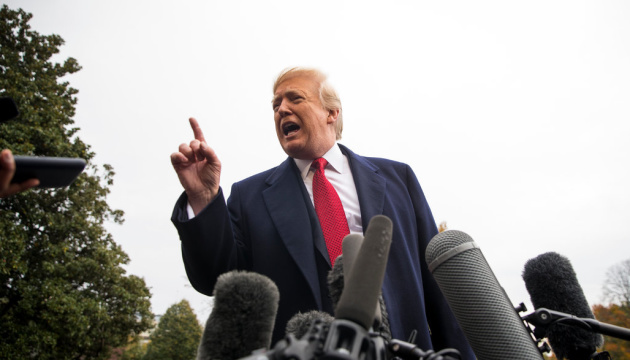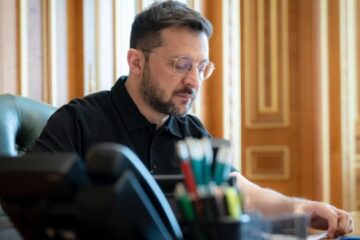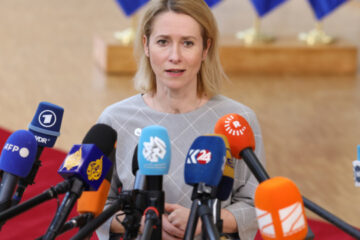Experts outline several possible scenarios for the development of events and potential implications for Ukraine
In recent weeks, the U.S. administration has increasingly made statements containing hints, and sometimes even explicit threats, about the possibility of the United States withdrawing from the negotiation process to resolve the war between Russia and Ukraine and abandoning its role as a mediator if no agreement is reached. In particular, Donald Trump has recently conceded he is sometimes “close to such a decision”, but added that “positive developments” are also happening, which again make him believe in the success of the diplomatic effort being made. He did not explain what exactly he meant by “positive developments”.
Messages signaling a possible change in the U.S. policy are coming in also from other office holders in the White House. US Secretary of State Marco Rubio has warned: the President may soon raise the issue of the advisability of further focused attention on the Russian-Ukrainian war, because Washington has to simultaneously respond to other challenges, in particular those emerging from China and Iran.
Vice President J.D. Vance, for his part, directly stated that “There is a wide gap” between Ukraine’s and Russia’s positions on peace, and therefore “the war is unlikely to end in the near future,” even though President Donald Trump has stressed he wants to broker a peace agreement between the two countries. He praised President Trump for getting the two sides to reveal their demands for ending the war, but said it will ultimately be up to Russia and Ukraine “to come to an agreement and stop this brutal conflict.” Speaking about the current state of negotiations with Russia and Ukraine, Vance said, “the first and necessary step of getting the Russia-Ukraine conflict solved is to get each of them to make a peace proposal.” “We’ve got the peace proposal out there and issued, and we’re going to work very hard over the next 100 days to try to bring these guys together,” he said.
Other representatives of the Trump administration, among them the White House spokesperson Karoline Leavitt spoke out in the same vein. But what is really behind this wave of statements? What are the real prospects for the development of the situation within the Kyiv-Washington-Moscow triangle? What scenarios look likely in the coming weeks and months?
DISMANTLING “PEACE ILLUSIONS”: WHY THE PROBABLE U.S. WITHDRAWAL FROM THE NEGOTIATIONS IS NOT A DISASTER, BUT AN OPPORTUNITY
What is behind the statements coming from Washington? Mykhailo Samus, defense analyst, director of the New Geopolitics Research platform, calls for a clarity in definitions. “First of all, what is meant by the ‘United States’ role in the negotiation process? If we are talking about Mr. Witkoff’s visits to Moscow, participation in prayers at St. Isaac’s Cathedral [in St. Petersburg], and subsequent secular events like eating caviar, then, excuse me, we don’t need such ‘mediation’.” Assessing the efforts made in recent months, Samus is categorical: “All we have seen over the past 100 days from the Trump administration is a systematic attempt to force Ukraine into surrender.” The analyst argues that the failure of these attempts is solely the merit of the Ukrainian side, saying, “That this has not been achieved during this time – despite the activity of Dmitriev, Witkoff, and all the attempts to influence Trump’s position – is solely because Ukraine did not agree to this scenario.” Mr. Samus reminds that Ukraine demonstrated a constructive attitude by signing a “joint communiqué with the United States on March 11 on readiness to cease fire without any preconditions being set by either side,” but at the same time Kyiv “made it clear that neither Crimea nor sovereignty can be a subject of bargaining – despite the pressure being exerted by Trump and members of his administration.” Hence the conclusion: “So if we are talking about the completion of this specific “negotiation process,” then this is, on the contrary, a positive news for Ukraine.”
Mr. Samus expresses satisfaction with the fact that “this diplomatic ‘corpse ballet’ may finally be reaching its logical conclusion.”
Diplomat Vadym Tryukhan offers a slightly different view of the situation. He believes that “Trump and his inner circle have already understood: they will not be able to achieve a quick end to the war in Ukraine, even theoretically. The reason is obvious – the positions of Ukraine and Russia are diametrically opposed. Russia seeks the destruction of Ukrainian statehood, while Ukraine is fighting for its own survival.” Faced with this reality, as well as with the “limited tools for influencing Putin” and fears of “a harsh response from Russia – in particular, a possible escalation of war,” the Trump team, according to Tryukhan, has resorted to “a kind of creative search – an attempt to find the optimal line of behavior for themselves.” Therefore, the current statements should be perceived calmly: “They are usually of a testing, situational nature… Statements are not yet decisions. Decisions are made behind the scenes and in a non-public format.”
An important aspect that could potentially change the balance of power is the rear earth minerals deal signed between the governments of Ukraine and the United States in late hours of May 1. Mykhailo Samus points to its preamble, which he asserts “almost no one is talking about”: “It clearly states that the United States of America and Ukraine recognize the contribution that Ukraine has made to strengthening international peace and security by voluntarily relinquishing the world’s third largest arsenal of nuclear weapons,” clearly referring to the Budapest Memorandum.” Samus believes this a key point: “This suggests that the U.S. cannot act as an impartial mediator. The United States is a party that has taken on specific obligations. After all, the memorandum unambiguously defines how the United States should have acted in the event of aggression against Ukraine. Namely: to support the victim of aggression – that is, Ukraine.”
REFORMATING ROLES: WASHINGTON BETWEEN COMMITMENTS AND PRAGMATISM, MOSCOW – IN EXPECTATION OF ESCALATION
The prospects for interaction within the Kyiv-Washington-Moscow triangle remain complex and unpredictable. Vadym Tryukhan comments: “Today, there are no signs of a dialogue being held in the format of the aforementioned triangle. We have separate bilateral relations: Washington-Moscow and Washington-Kyiv. On the other hand, the Kyiv-Moscow track is practically absent, as is any trilateral format. Currently, there are no implemented or even realistic ideas existing in nature on how negotiations could be organized with the participation of Americans, Russians, and Ukrainians. Such a prospect is theoretically possible, but not in the near future.”
Tryukhan interprets the comment by US Vice President J.D. Vance about the White House’s task for the next 100 days to “try to bring the positions of the parties closer together” as evidence that “the format of negotiations, as we see now, is gradually moving into a long-term phase, without elements of haste or excessive expectations. The task of achieving “a quick end to the war” has obviously become a secondary priority.”
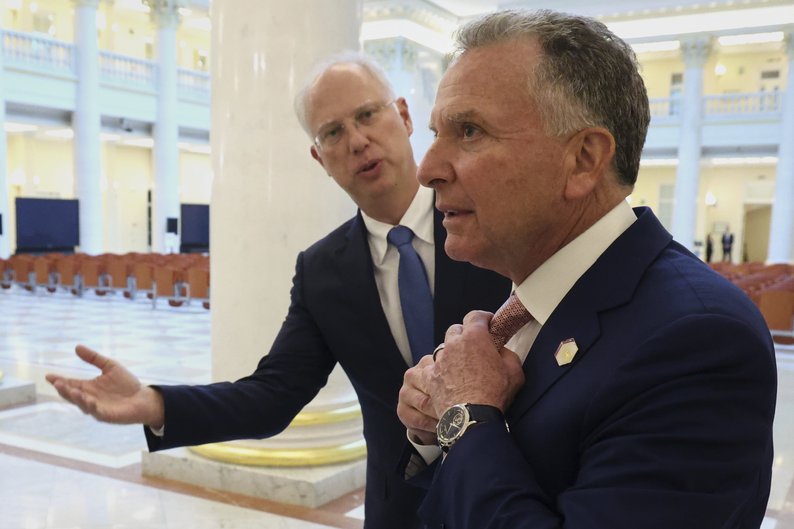
Photo: Kirill Dmitriev and Steve Witkoff / AP/Vyacheslav Prokofyev
Mykhailo Samus analyzes in detail the failure of previous attempts at “peacemaking,” in particular the so-called Witkoff-Dmitriev track. This track was intended to “draw Trump into appealing business projects” with the Russian Federation – natural gas, crude oil, gold, diamonds from Yakutia, gas pipelines to Europe. This was a fantasy that was vigorously promoted by Witkoff and Dmitriev,” with the ultimate goal of “freezing the war, weakening Euro-Atlantic unity, gradually destroying Ukraine – first from the inside, and then from the outside, not excluding by using military force.” However, this “fantasy” has crashed into reality. “Currently, the so-called “retrograde tower” has prevailed in Russia – Patrushev, Chemezov, Kiriyenko and others… The “old guard” sitting in the Kremlin has won. And they have little interest in the war to end, in Russia sanctions to be lifted, nor in economic rapprochement with the United States. They are guided by the logic of the military-industrial complex – war is a resource, an opportunity rather than a problem for them.” That is why, according to Samus, “we have actually returned to the starting point… Putin is absolutely not set on a ceasefire, on stopping the war, but, on the contrary, we are already witnessing preparations for another summer escalation.”
Under these circumstances, the analyst continues, the U.S.’ departure from the “dubious format” of the negotiations could become a chance for Washington to move over “to a clearer position: not balancing between the aggressor and the victim, but providing systematic support for Ukraine as a country fighting for its existence.” He believes that “the United States should take a substantially tougher position on Russia… They should respond immediately: strengthen and expand existing sanctions, introduce a full embargo on Russian crude oil, limit its access to technology from overseas, oust Russia from energy markets. This is what an adequate response to the challenges should be like.”
Economic pressure is an important tool. “The Russian economy is deteriorating very rapidly. Budget revenues are decreasing, global crude oil prices have plunged. This creates critical risks for financial sustainability of the regime,” the expert notes. Trump’s planned trip to Saudi Arabia on May 13 for talks on increasing oil production, according to Samus, “will deliver an even harder blow to the Russian budget.” Meanwhile, Ukraine, he reminds, “has on numerous occasions bluntly told the American side: we don’t need to be convinced that we want peace. This is obvious. We didn’t start this war, neither did we ever planned it. Instead, the American strategy was to convince precisely Ukraine instead of putting pressure on the aggressor.”
PREDICTABLE SCENARIO: FROM “FREEZE” TO A STRATEGIC EDGE FOR UKRAINE
Analysts outline several possible scenarios for the development of events, each with own distinctions and implications for Ukraine.
Mykhailo Samus predicts three possible scenarios:
The United States for a short time becomes less visible in its peace-brokering campaign: “The United States may temporarily reduce the level of its active involvement in the effort to resolve the Russian-Ukrainian war… This is not about a complete withdrawal from the process, but rather about refocusing to other priorities – in particular, relations with Saudi Arabia, energy policy or tariff issues.” A return to an active role is possible in Fall, when “a new political season starts in the United States, the new budget cycle begins, and the first outlines of the upcoming races for the Congressional by-elections become visible. This is critically important for the Republican Party.” If “Kyiv manages to hold out during summer, and Russia does not achieve significant successes on the battlefield and faces a deteriorating economic outlook, this will create a favorable background for new initiatives from Washington. Perhaps at this stage, the rear earth minerals deal will come into effect.”
The oil factor and a new round of negotiations: If Trump’s visit to Saudi Arabia is a success and global oil prices continue to fall, “alarming signals may begin to sound among Putin’s entourage – for example, from figures such as aforementioned Kirill Dmitriev, warning that, should the current trends continue, the Russian economy may not last until the end of the year: there will not be enough resources to simultaneously wage the war, maintain the social sector expenditure and support overall economic resilience.” This may create a “new window of opportunity” for the United States. “For example, after a trip to SA, Trump will call Putin and ask: “So, what prospects can we have?” And Putin, hypothetically, will reply: “Listen, I thought it over and decided that the previous conditions (Dmitriev-Witkoff) suit me well.” However, Samus emphasizes, this time around “Trump will be able to afford to have a tougher dialogue with Putin: first – a ceasefire, and only then – a conversation about sanctions. Not the other way around.”
Increasing pressure on Russia: “After Trump’s trip to Saudi Arabia, there has been no direct contact with Putin. Instead, Trump is being told that now is the time to increase pressure on Russia.” After all, Moscow is demonstrating a complete lack of a constructive position and is instead moving into the active phase of the summer war campaign. This opens up a perfect window of opportunity for delivering a painful strike to the Russian economy”. The Kremlin’s stubbornness, who “is escalating hostilities instead of seeking a ceasefire,” is “a demonstrative slap in the face to Trump, who promised to end the war in Ukraine in 24 hours.” As a result, “Trump may well resort to tougher measures,” for example, by supporting Senator Lindsey Graham’s bill on a “ 500% tariff on imports from any country that continues to purchase Russian oil, gas or uranium. The measure, introduced with bipartisan support, is aimed at compelling the Russian leadership to engage in substantive negotiations to end the war”. Samus considers this scenario “the most favorable for Ukraine,” though he adds with his characteristic irony: “I deliberately avoid terms such as catastrophe, because I am convinced that Russia, like North Korea, is capable of existing in a semi-isolated state for a long time. Such is the “population” in the Russian Federation: even when there is nothing to eat, they continue to pray to Putin. However, the fact that the situation in Russia will become much worse is beyond doubt.”
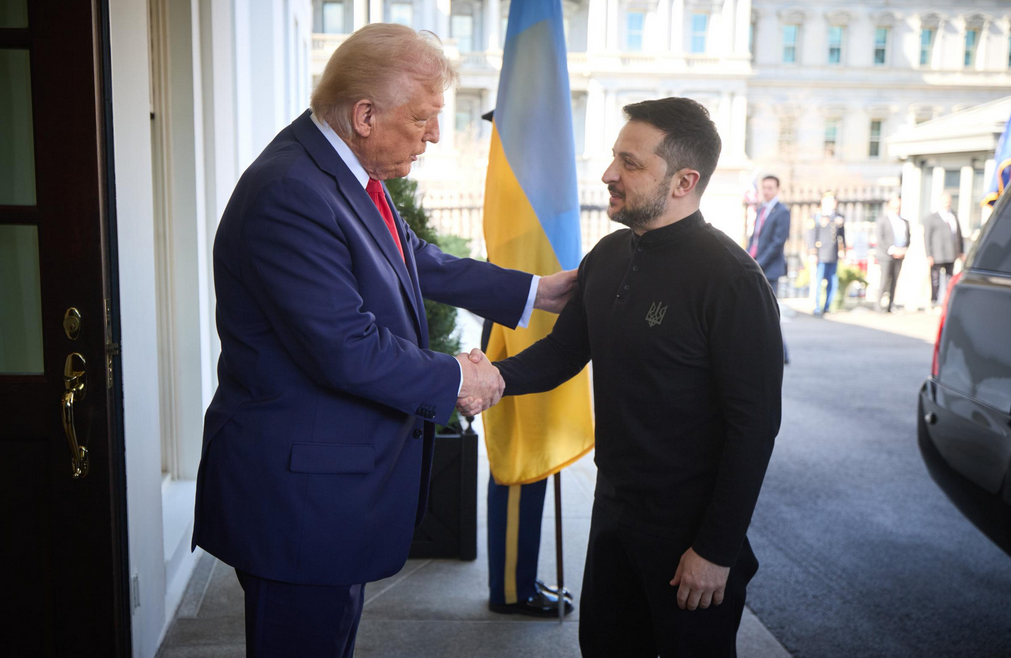
Photo: Presidents Donald Trump of the USA and Volodymyr Zelensky of Ukraine
Vadym Tryukhan offers three scenarios that complement the overall picture:
The diplomatic process is slowed to a crawl: “Continuation of a fragmented, gradual negotiation process that will stretch for several months, possibly a year or even longer.” With the involvement of the US, the EU, Turkey and others, against the background of “the gradual weakening of Russia – primarily due to the fall in global oil prices, a decline in its export capabilities and further economic isolation.” As a result of this pressure, Putin may come to understand that he has not enough resources to continue the full-scale war. And in this case, “Putin will be forced to agree to a certain compromise, extremely unfavorable for him personally, but one that he can present to his internal audience as a “victory” or “preservation of what has been achieved”. Hypothetically, this could be a “freezing of the conflict” along the de facto demarcation line.”
The US withdraws from the negotiations, with unpredictable consequences: “Donald Trump may indeed withdraw from the negotiation process… The war may take the form of a protracted conflict – following the example of the Iran-Iraq war, which lasted for decades – with the simultaneous attrition of both sides. In our case, such a scenario may drag on for a year or even two.” The key question here is “How exactly will the U.S. withdraw from the process? If it comes to the termination of military support for Ukraine, that is one reality. And it is not entirely positive for us.”
Strategic move: the US withdraws from the negotiations, but increases support for Ukraine. “If the United States, having withdrawn from the negotiations, at the same time maintains or even increases assistance to Kyiv, that is a completely different scenario,” which Tryukhan considers “the most desirable for Ukraine.” He sees signs of this in the fact that “the American side is beginning to implement mechanisms by which Ukraine gains access to weapons, technologies, training, in particular as part of F-16 training program for Ukrainian pilots. Such decisions, even if they are framed as sales rather than direct assistance, signal the U.S. gradual return to the active phase of supporting Ukraine.” Such a development, in his opinion, “opens up the prospects for serious military successes for Ukraine – not only tactical, but also operational-strategic, such as the encirclement or even destruction of large groups of Russian forces. If this scenario comes true, the discourse will change. It will return from the theme of a “just peace” to the rhetoric of “Ukraine’s victory”… “It is extremely important for Ukraine to restart the victorious narrative – with a clear focus on how to defeat the barbarians.”
SUMMER-FALL CAMPAIGN: ATTRITION WAR AND UKRAINIAN ADAPTABILITY
According to experts, the coming months will be difficult, but not devoid of opportunities for Ukraine to influence the situation.
Mykhailo Samus notes that “the attempt by Witkoff and Dmitriev to offer Russia a way out of the catastrophe was, in fact, a lifeline.” But the Kremlin has squandered this chance. “Putin is absolutely not in the mood for a ceasefire – at least until Fall, when the result of his summer campaign will become clear. Like I’ve said already, the Kremlin has decided to allow its “old guard” – the elite inner core of the KGB – time until Fall to implement their plans on the battlefield.” Against this background, the analyst continues, the US should not act as a bystander, but “act decisively… be closely engaged and exerting pressure right now.”
Vadym Tryukhan is expecting “sporadic, chaotic attempts by the Russian army to break through Ukrainian defense lines in specific locations while simultaneously increasing the intensity of strikes on Ukrainian cities and civilian infrastructure, and this scenario seems to become apparent now. The adversary is persistently attacking peaceful cities: Kyiv, Kharkiv, Odesa… These strikes are part of a strategy of deliberate terror against civilians, aimed not only at destroying critical infrastructure, but also at exhausting the population psychologically.” The Ukrainian response, in his opinion, should be to “consistently ramp up the national air defense capability to minimize the impact of these attacks. Ukraine, for its part, will increase the number and intensity of attacks on enemy’s infrastructure. And the further, the more painful these actions will be for Russia.” The war, the analyst argues, “is increasingly taking on the form of drone warfare – both in the air and at sea – with the intensive use of electronic warfare systems. Over the coming months, until Fall or even late Fall, this is exactly how the main format of combat operations will look like.” At the same time, Mr. Tryukhan does not expect any significant breakthroughs from either side: “Russia simply does not have enough forces and resources for this, despite attempts to mobilize the greatest number of volunteers for war. Ukraine, in its turn, has limited human resources and supply of weapons.” However, the Ukrainian side is going to continue its “pinpoint operations – such as the situation around Tyotkino in Russia’s Kursk region, aimed to distract enemy forces and “defeat the Kremlin’s narrative about the progress of the war.” Mr. Tryukhan concludes his forecast on an optimistic, albeit somewhat ominous note for the adversary: “Yes, this period will be difficult, but predictable at the same time. And although the first Russian Sukhoi fighters downed by Ukrainian forces have already become a symbolic event, these are just flowers, grains still ahead.
CONCLUSION NOTES
The US statements about a possible revision of the format of its involvement in the peace settlement are not necessarily a sentence for Ukraine. On the contrary, regarding an end to the existing format, which is more reminiscent of attempts to persuading Ukraine into concessions rather than a meaningful mediation, such an “exit” may open the way to a more straightforward and principled policy on the part of Washington. As Mykhailo Samus underscored, “Today, both Trump and Witkoff are in complete surprise over how conspicuously Putin has demonstrated contempt even for them. And that is why now is the best opportune moment for the United States to abandon its deceitful role as a mediator and switch over to the policy of force, policy of principles.” This is perhaps exactly the chance that Ukraine will be able to take advantage of.
Myroslav Liskovych, Kyiv

